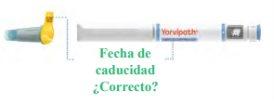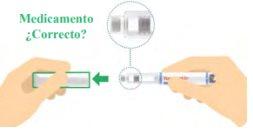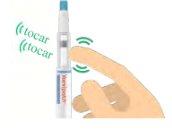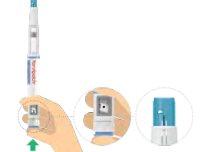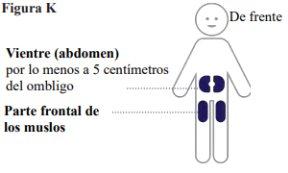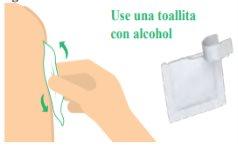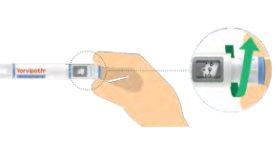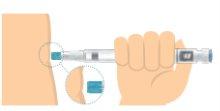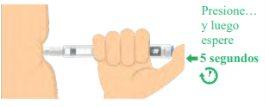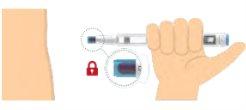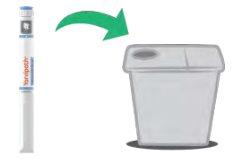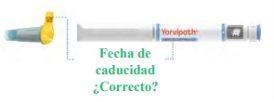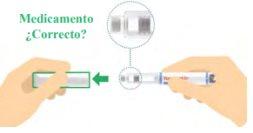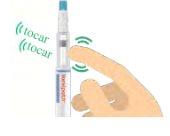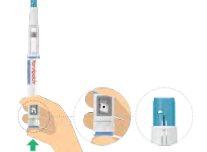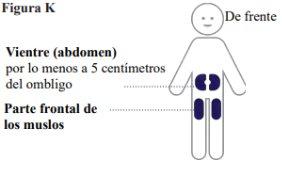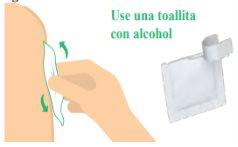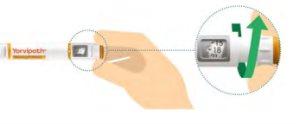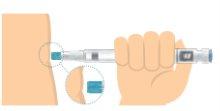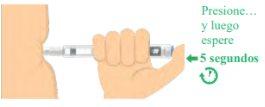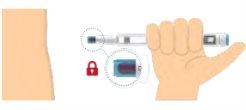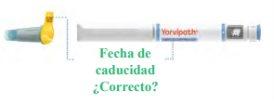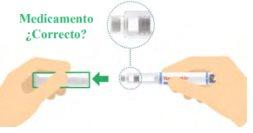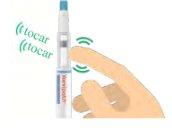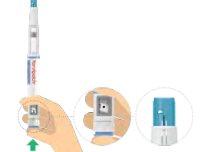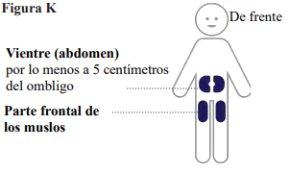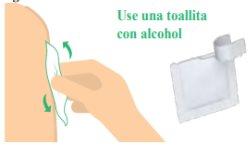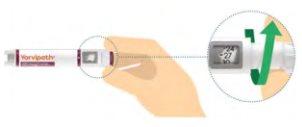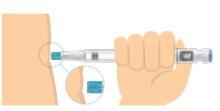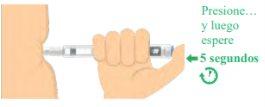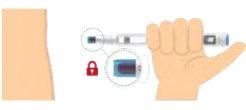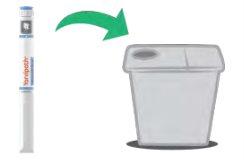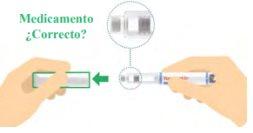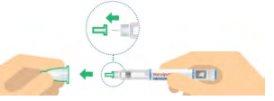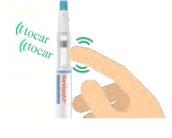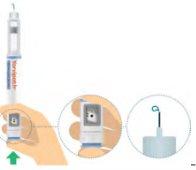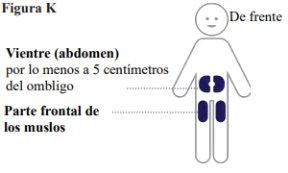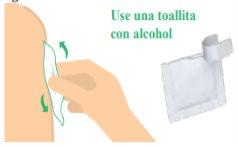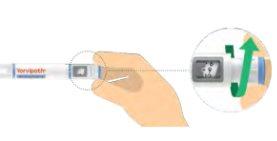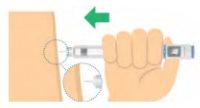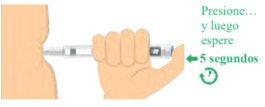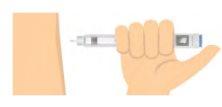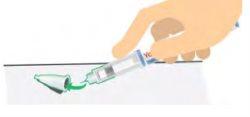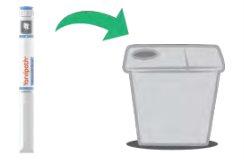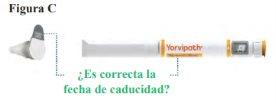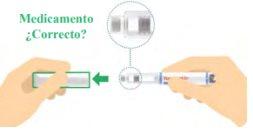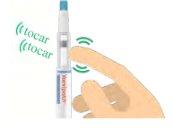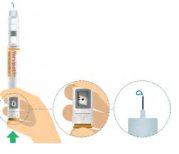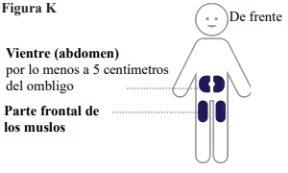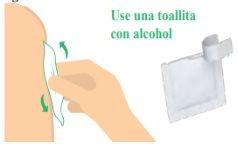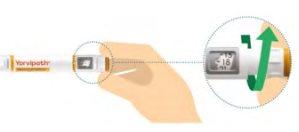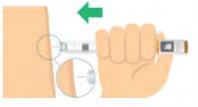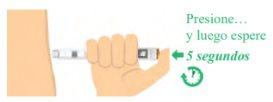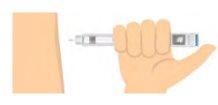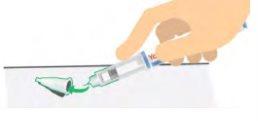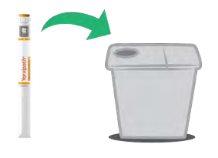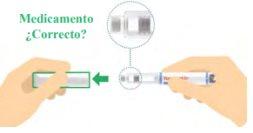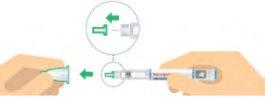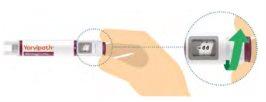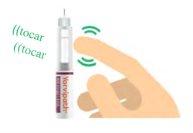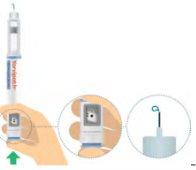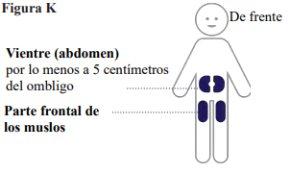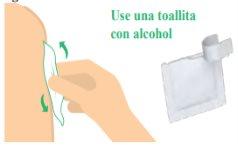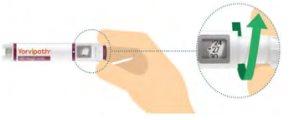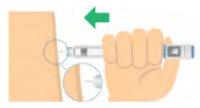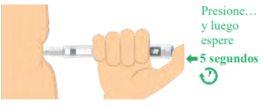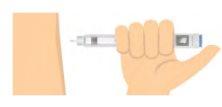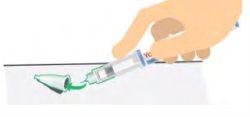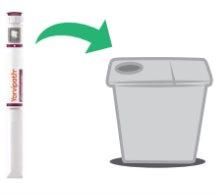
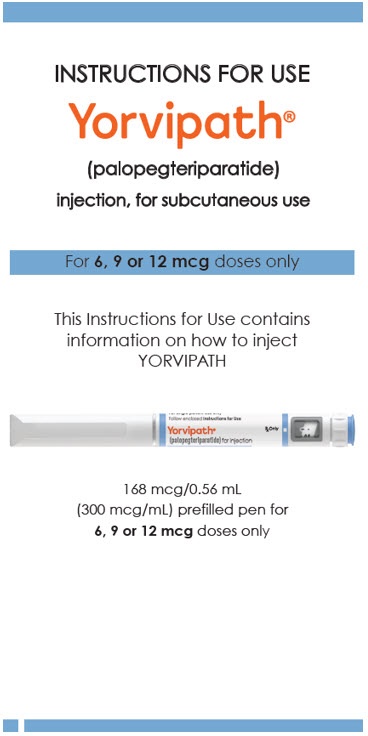
YORVIPATH 168 micrograms/0.56 ml injectable solution in pre-filled pen

Ask a doctor about a prescription for YORVIPATH 168 micrograms/0.56 ml injectable solution in pre-filled pen

How to use YORVIPATH 168 micrograms/0.56 ml injectable solution in pre-filled pen
Introduction
Leaflet: information for the patient
Yorvipath 168 micrograms/0.56 ml solution for injection in pre-filled pen
Yorvipath 294 micrograms/0.98 ml solution for injection in pre-filled pen
Yorvipath 420 micrograms/1.4 ml solution for injection in pre-filled pen
palopegteriparatide
This medicine is subject to additional monitoring, which will allow for quicker identification of new safety information. You can help by reporting any side effects you may have. The last section of section 4 will tell you how to report side effects.
Read all of this leaflet carefully before you start using this medicine because it contains important information for you.
- Keep this leaflet, you may need to read it again.
- If you have any further questions, ask your doctor or pharmacist.
- This medicine has been prescribed for you only. Do not pass it on to others. It may harm them, even if their signs of illness are the same as yours.
- If you get any side effects, talk to your doctor or pharmacist. This includes any possible side effects not listed in this leaflet. See section 4.
Contents of the pack
- What is Yorvipath and what is it used for
- What you need to know before you use Yorvipath
- How to use Yorvipath
- Possible side effects
- Storage of Yorvipath
- Contents of the pack and other information
1. What is Yorvipath and what is it used for
Yorvipath contains the active substance palopegteriparatide. Palopegteriparatide becomes teriparatide, also known as parathyroid hormone (PTH), in the body. PTH is normally produced in the body and is necessary to keep the amount of calcium and phosphate in your body within normal limits.
Yorvipath is used to treat chronic hypoparathyroidism in adults. In people with hypoparathyroidism, the body produces very little or no PTH. Because of this, they cannot keep calcium and phosphate levels within normal limits, which leads to symptoms of the condition, such as muscle spasms, twitching, and tingling sensation in the fingertips, toes, and lips. Yorvipath replaces the missing PTH to control calcium and phosphate levels.
2. What you need to know before you use Yorvipath
Do not use Yorvipath
- if you are allergic to palopegteriparatide or any of the other ingredients of this medicine (listed in section 6)
- if you have pseudo hypoparathyroidism, a condition where the body does not respond properly to the parathyroid hormone produced by the body
Warnings and precautions
Talk to your doctor, pharmacist, or nurse before starting treatment with Yorvipath.
If you are being treated with Yorvipath, you may experience side effects related to low and high levels of calcium in the blood (see section 4 for more information). These effects are more likely to occur when starting treatment or changing the dose. Your doctor will monitor your calcium levels (see "Tests and checks" in section 3). You may be given medicines to treat or help prevent these side effects, or your doctor may adjust the dose.
High levels of calcium in the blood can cause problems if you are taking medicines that contain cardiac glycosides (such as digoxin or digitoxin) (see Other medicines and Yorvipath). Your doctor will monitor your calcium levels (see "Tests and checks" in section 3) and cardiac glycosides and will monitor you for signs and symptoms.
If you are taking Yorvipath and have severe liver or kidney impairment, your doctor will monitor your calcium levels more frequently (see "Tests and checks" in section 3).
Tell your doctor if you have a higher risk of a type of bone cancer called osteosarcoma. This is especially important:
- if you have received radiation therapy to the bones
- if you have bone cancer or another type of cancer that has spread to the bones
- if you have a bone disease that increases the risk of developing osteosarcoma (e.g., if you have Paget's disease)
- if a blood test shows that you have unexplained increases in bone alkaline phosphatase
If you are at risk of bone fractures, your doctor will monitor you for osteoporosis.
Children and adolescents
Yorvipath should not be used in children and adolescents under 18 years of age as it has not been studied in this age group.
Other medicines and Yorvipath
Tell your doctor, pharmacist, or nurse if you are using, have recently used, or might use any other medicines. In particular, tell your doctor if you are using or have recently used any of the following medicines:
- Heart medicines that contain cardiac glycosides (such as digoxin or digitoxin)
- Medicines for the treatment of osteoporosis such as bisphosphonates, denosumab, or romosozumab
- Medicines that may affect calcium levels in the blood, such as diuretics ("water tablets", such as hydrochlorothiazide or furosemide), systemic corticosteroids (medicines used to treat inflammation), and lithium (a medicine used to treat mood disorders)
Your doctor may need to adjust the dose of these medicines or the dose of Yorvipath.
Pregnancy, breast-feeding, and fertility
If you are pregnant or breast-feeding, think you may be pregnant, or are planning to have a baby, ask your doctor or pharmacist for advice before using this medicine.
Pregnancy
If you are pregnant or think you may be pregnant, talk to your doctor. If you become pregnant during treatment, tell your doctor right away.
Information on the safety of Yorvipath in pregnant women is limited. Your doctor will decide if you should be treated with Yorvipath during pregnancy. If you are pregnant or planning to become pregnant, your doctor will monitor your calcium levels.
Breast-feeding
If you are breast-feeding or planning to breast-feed, ask your doctor for advice before using Yorvipath. Your doctor will decide if you should be treated with Yorvipath during breast-feeding. If you are breast-feeding, your doctor will monitor your calcium levels.
Fertility
It is not known if Yorvipath has effects on fertility.
Driving and using machines
Yorvipath has no or negligible influence on the ability to drive and use machines. However, if you experience dizziness or fainting when standing up, do not drive or use machines until you feel better.
Yorvipath contains sodium
This medicine contains less than 1 mmol of sodium (23 mg) per dose, which is essentially "sodium-free".
3. How to use Yorvipath
Follow the instructions for administration of this medicine exactly as told by your doctor or nurse. If you are not sure, talk to your doctor again.
Yorvipath is given as an injection under the skin (subcutaneous injection). This means it is injected with a short needle into the fatty tissue under the skin. The medicine should be injected into the abdomen or the front of the thigh, and it is important to inject it every day in a different area to avoid damaging the skin. You can alternate between the right and left side of the abdomen and the front of the left and right thigh.
Before you start using the pen for the first time, your doctor, pharmacist, or nurse will show you how to inject Yorvipath. You will find additional help on using Yorvipath in the instructions for useat the end of this leaflet.
Always use the pen as described in the instructions for use.
Starting, changing, and maintaining Yorvipath
Your doctor will do a blood test to check your calcium and vitamin D levels before starting treatment with Yorvipath.
The recommended starting dose of Yorvipath is 18 micrograms once a day. Your doctor will tell you to gradually change the dose based on your response to the medicine, until you are using a dose that keeps the amount of calcium in your body within normal limits without the need for active vitamin D or therapeutic doses of calcium. You may need to continue taking daily calcium supplements to meet your dietary needs. Your dose may be increased if at least 7 days have passed since the last dose change. Your dose may be decreased no more than every 3 days when the calcium level in your body is too high.
Tests and checks
Your doctor will monitor your response to treatment:
- 7 days after starting treatment and
- 7 to 14 days after changing the dose
This will be done through tests to measure the level of calcium in the blood or urine. Your doctor will tell you to change the amount of calcium or vitamin D you take (in any form, including calcium-rich foods).
Instructions for use
If your dose is more than 30 micrograms per day:
- Give two injections, one after the other, in different injection areas.
- It is recommended to use a different Yorvipath pen for the second daily injection, even if the two pens have the same color pusher (same concentration).
- The following table explains how to administer the dose. If you are unsure, talk to your doctor again.
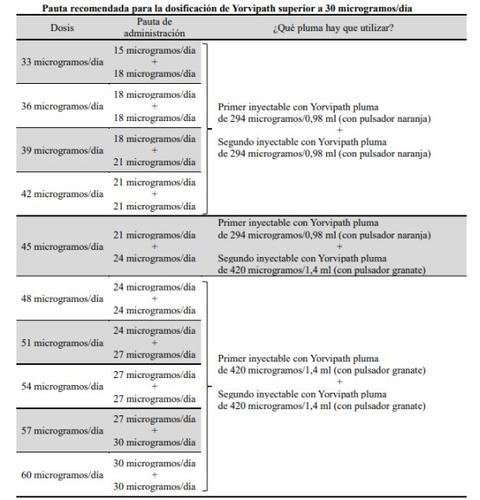
Yorvipath pen 294 micrograms/0.98 ml delivers doses of 15, 18, or 21 micrograms (with orange pusher)
Yorvipath pen 420 micrograms/1.4 ml delivers doses of 24, 27, or 30 micrograms (with burgundy pusher)
If you use more Yorvipath than you should
Contact your doctor or nurse immediately and tell them the symptoms you have.
Overdose can lead to high levels of calcium in the blood. Symptoms may include, but are not limited to, feeling sick (vomiting), dizziness, feeling thirsty, confusion, muscle weakness, and irregular heartbeat. For more information, see section 4.
If you forget to use Yorvipath
If you forget to inject a dose of Yorvipath, you can use the medicine as soon as you remember if it is less than 12 hours since the missed dose. For example, if you normally inject the medicine at 08:00, you can inject the missed dose before 20:00.
If you only remember to use the dose within 12 hours of your next scheduled dose, skip the missed dose and continue injecting the next dose as you normally do. For example, if you remember at 22:00 that you forgot to inject Yorvipath and your next dose is scheduled for 08:00, you should not inject the missed dose.
Never take a second dose to make up for a missed dose.
If you stop treatment with Yorvipath
Do not stop using Yorvipath without talking to your doctor. If you stop treatment with Yorvipath, calcium levels in the blood may decrease, and you may develop the symptoms described below (see section 4).
If you have any other questions about using Yorvipath, ask your doctor or nurse.
4. Possible side effects
Like all medicines, this medicine can cause side effects, although not everybody gets them.
Some side effects can be serious
Common serious side effects (may affect up to 1 in 10 people):
- High levels of calcium in the blood (hypercalcemia)
- Symptoms may include, but are not limited to, feeling sick (vomiting), dizziness, feeling thirsty, confusion, muscle weakness, and irregular heartbeat.
- Hypercalcemia is more likely to occur in the first 3 months of starting treatment or if you change your dose of Yorvipath.
- Low levels of calcium in the blood (hypocalcemia)
- Symptoms may include, but are not limited to, tingling sensation in the fingertips, toes, and lips (paresthesia), muscle spasms and cramps, oral numbness, and seizures.
- Hypocalcemia is more likely to occur if you stop taking Yorvipath for a short period or completely or if you change your dose of Yorvipath.
Tell your doctor immediately if you experience any of the symptoms mentioned above that may be signs of these side effects. Your doctor will monitor your calcium levels. You may need to have your dose of Yorvipath changed or the injections stopped for a short period. You may be given medicines to treat or help prevent these side effects, or you may be asked to stop taking some of the medicines you are taking. These medicines include calcium or vitamin D. You may be asked to have some laboratory tests.
Other side effects include:
Very common side effects(may affect more than 1 in 10 people)
- Headache
- Tingling sensation in the fingertips, toes, and lips (paresthesia)
- Feeling sick (nausea)
- Feeling tired (fatigue)
- Redness, bruising, pain, bleeding, rash, or swelling at the injection site (injection site reactions)
Common side effects(may affect up to 1 in 10 people)
- Feeling of heartbeat or very fast heartbeat (palpitations)
- Dizziness
- Feeling of being about to lose consciousness (presyncope)
- Fainting (syncope)
- Dizziness, lightheadedness, or fainting when sitting or standing up (orthostatic hypotension)
- Dizziness, lightheadedness, or fainting and increased heart rate when sitting or standing up (postural orthostatic tachycardia syndrome)
- Sore mouth or sore throat (oropharyngeal pain)
- Diarrhea
- Constipation
- Feeling sick (vomiting)
- Abdominal pain
- Abdominal discomfort
- Joint pain (arthralgia)
- Muscle pain (myalgia)
- Weakness (asthenia)
- Thirst
- Rash
- Skin reaction to sunlight (photosensitivity reaction)
- Need to urinate at night (nocturia)
- Muscle twitching
- Pain in the bones and muscles (musculoskeletal pain)
Uncommon side effects(may affect up to 1 in 100 people)
- Chest pain
- Chest discomfort
- High blood pressure (hypertension)
Frequency not known(cannot be estimated from the available data)
- Need to urinate frequently (polyuria)
- Decreased bone density
If you experience any side effects or symptoms that worry you, tell your doctor or nurse.
Reporting of side effects
If you experience any side effects or symptoms, talk to your doctor, pharmacist, or nurse, even if they are not listed in this leaflet. You can also report side effects directly through the national reporting system listed in Appendix V. By reporting side effects, you can help provide more information on the safety of this medicine.
5. Storage of Yorvipath
Keep this medicine out of the sight and reach of children.
Do not use this medicine after the expiry date which is stated on the carton after EXP. The expiry date is the last day of the month shown.
Before first use:
Store in a refrigerator (2°C to 8°C). Do not freeze.
Store in the original package with the pen cap on to protect from light.
After first use:
Store below 30°C.
Store the pen cap on the pre-filled pen to protect from light.
Discard the pens 14 days after first use.
Do not use this medicine if you notice that the solution is cloudy, discolored, or contains visible particles.
Medicines should not be disposed of via wastewater or household waste. Ask your pharmacist how to dispose of medicines no longer required. This will help protect the environment.
6. Container Contents and Additional Information
Yorvipath Composition
- The active ingredient is palopegteriparatida.
- The other excipients are succinic acid, mannitol, metacresol, sodium hydroxide (see section 2, "Yorvipath contains sodium"), hydrochloric acid (for pH adjustment), and water for injectable preparations.
Yorvipath is a solution for subcutaneous injections in a pre-filled pen available in three presentations:
Yorvipath 168 micrograms/0.56 ml
Each pre-filled pen contains palopegteriparatida equivalent to 168 micrograms of PTH(1-34) in 0.56 ml of solvent. The concentration based on PTH(1-34) is 0.3 mg/ml.
Yorvipath 294 micrograms/0.98 ml
Each pre-filled pen contains palopegteriparatida equivalent to 294 micrograms of PTH(1-34) in 0.98 ml of solvent. The concentration based on PTH(1-34) is 0.3 mg/ml.
Yorvipath 420 micrograms/1.4 ml
Each pre-filled pen contains palopegteriparatida equivalent to 420 micrograms of PTH(1-34) in 1.4 ml of solvent. The concentration based on PTH(1-34) is 0.3 mg/ml.
Product Appearance and Container Contents
Yorvipath is a clear and colorless injectable solution in a pre-filled pen.
Yorvipath is available in packs containing 2 pre-filled pens (with 30 disposable or needle-free needles) for 28 days of treatment. Each pre-filled pen is for 14 days of treatment.
Only some pack sizes may be marketed.
The concentration colors are indicated on the outer and inner boxes, on the label, and on the pre-filled pen's push button, as follows:
Color | Presentation |
Blue | Yorvipath 168 micrograms/0.56 ml |
Orange | Yorvipath 294 micrograms/0.98 ml |
Burgundy | Yorvipath 420 micrograms/1.4 ml |
Marketing Authorization Holder
Ascendis Pharma Bone Diseases A/S
Tuborg Boulevard 12
DK-2900 Hellerup
Denmark
Manufacturer
Ascendis Pharma A/S
Tuborg Boulevard 12
DK-2900 Hellerup
Denmark
You can request more information about this medicinal product by contacting the local representative of the marketing authorization holder:
België/Belgique/Belgien Ascendis Pharma Bone Diseases A/S Tel: +32 2 790 6340 | Lietuva Ascendis Pharma Bone Diseases A/S Tel: +45 70 22 22 44 |
| Luxembourg/Luxemburg Ascendis Pharma Bone Diseases A/S Tel: +45 70 22 22 44 |
Ceská republika Ascendis Pharma Bone Diseases A/S Tel: +45 70 22 22 44 | Magyarország Ascendis Pharma Bone Diseases A/S Tel: +45 70 22 22 44 |
Danmark Ascendis Pharma Bone Diseases A/S Tlf: +45 88 74 22 67 | Malta Ascendis Pharma Bone Diseases A/S Tel: +45 70 22 22 44 |
Deutschland Ascendis Pharma Bone Diseases A/S Tlf: +45 88 74 22 67 | Nederland Ascendis Pharma Bone Diseases A/S Tel: +31 20 259 2731 |
Eesti Ascendis Pharma Bone Diseases A/S Tel: +45 70 22 22 44 | Norge Ascendis Pharma Bone Diseases A/S Tlf: +47 23 50 24 80 |
Ελλáδα Ascendis Pharma Bone Diseases A/S Τηλ: +45 70 22 22 44 | Österreich Ascendis Pharma Bone Diseases A/S Tel: +43 1 205 636 7700 |
España Ascendis Pharma Iberia, S.L. Tel: +34 910 798 364 | Polska Ascendis Pharma Bone Diseases A/S Tel: +45 70 22 22 44 |
France Ascendis Pharma France SAS Tél: +33 1 72 35 02 00 | Portugal Ascendis Pharma Bone Diseases A/S Tel: +351 21 124 8316 |
Hrvatska Ascendis Pharma Bone Diseases A/S Tel: +45 70 22 22 44 | România Ascendis Pharma Bone Diseases A/S Tel: +45 70 22 22 44 |
Ireland Ascendis Pharma Bone Diseases A/S Tel: +44 20 4570 1942 | Slovenija Ascendis Pharma Bone Diseases A/S Tel: +45 70 22 22 44 |
Ísland Ascendis Pharma Bone Diseases A/S Sími: +45 70 22 22 44 | Slovenská republika Ascendis Pharma Bone Diseases A/S Tel: +45 70 22 22 44 |
Italia Ascendis Pharma Bone Diseases A/S Tel: +39 02 8128 1581 | Suomi/Finland Ascendis Pharma Bone Diseases A/S Puh/Tel: +358 64 60 41 367 |
Κúπρος Ascendis Pharma Bone Diseases A/S Τηλ: +45 70 22 22 44 | Sverige Ascendis Pharma Bone Diseases A/S Tel: +46 8 502 414 23 |
Latvija Ascendis Pharma Bone Diseases A/S Tel: +45 70 22 22 44 |
Date of Last Revision of this Leaflet: April 2025
Other Sources of Information
Detailed information on this medicinal product is available on the European Medicines Agency website: https://www.ema.europa.eu. There are also links to other websites on rare diseases and orphan medicines.
The European Medicines Agency website has this leaflet in all languages of the European Union/European Economic Area.
On the other side of this leaflet, you will find the instructions for use with information on how to inject Yorvipath.
--------------------------------------------------------------------------------------------------------------------
INSTRUCTIONS FOR USE
Yorvipath
168 micrograms/0.56 ml
For doses of 6, 9, or 12 microgramsonly
Injectable solution in a pre-filled pen
palopegteriparatida
Subcutaneous route
The instructions for use contain
information on how to inject
Yorvipath
Additional Information
If you do not understand or are unable to complete any of the steps described in the instructions for use, consult your doctor or nurse.
Important Information You Should Know Before Starting to Use Your Yorvipath Pen Read and follow the leaflet and these instructions for use carefully to be able to inject Yorvipath correctly. Make sure you have received training from your doctor or nurse before applying the injection. This is important to ensure you receive the correct treatment. For Correct Use
|
Pen Care
|
Troubleshooting
You should only test the pen's flow (section 2) the first time you use a new pen (or if you think it might be damaged) to avoid wasting medication. The test checks to ensure the medication flows through the pen so you can receive the correct doses of the medication.
If you don't see drops at the tip of the needle after 5 attempts, it may be because there is no flow in the pen and needle. Change the needle (see section 5, step 13) and retest the pen's flow (see section 2, steps A-C). You can ensure the flow is working correctly if you see the medication drop. If it still doesn't work, discard the pen and consult your healthcare professional.
The injection is only complete when you press the push button all the way down and the dose selector has returned to the "?" position and you have left the needle in the skin for 5 seconds.
Some of the medication may flow back into the pen or retreat from the injection site and remain in the skin. Pressing the pen against the skin for 5 secondshelps ensure that all the medication is injected.
The pen does not allow setting a dose larger than the amount of medication left. If your dose is larger than the amount of medication left in the pen, you will not be able to set a complete dose. You must discard your pen and take the complete dose of the medication with a new one.
Unscrew and discard the needle in use (see section 5, step 13). Take a new needle from the box and start again from step 1. All boxes contain an additional needle. |
Overview of the Parts
Figure A
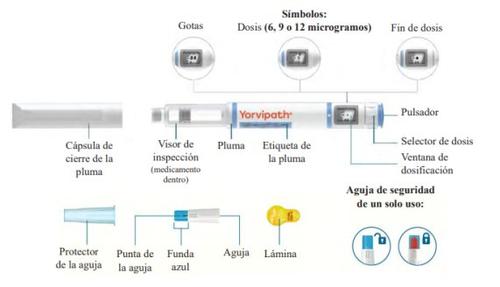
Note:There is no medication inside the needle.
You will also need
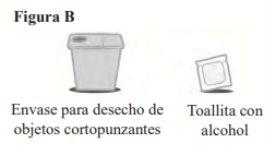
1 Preparing the Pen and Needle | |
Step 1 Take your Yorvipath pen. Make sure it is the correct concentration and check the expiration date.Take a needle and check the expiration dateon the needle (Figure C). Note:Remove your pen from the refrigerator 20 minutes before the first use. | Figure C
|
Step 2 Remove the cap from the pen and check the inspection window to ensure the medication inside the pen is transparent and colorless (Figure D). Important:If the medication has visible particles do notuse the pen. Use a new pen. | Figure D
|
Step 3 Remove the needle shield (Figure E). This needle can only be used onceand is locked after use. Always use a new needle for each injection. | Figure E
|
Step 4 Attach the needle directlyto your pen, and then screw the needle onto the pen until it is secure (it will not fully tighten) (Figure F). | Figure F
|
Step 5 Remove the needle protector (Figure G) and discard it. Important:The blue cap should not be touched as it may block the needle. | Figure G
|
|
|
| Test the pen's flow (steps A-C) only the first time you use a new pen. If your pen is already in use, go to section 3 "Prepare the injection and select the dose". |
Step A Turn the dose selector to the right 2 clicksuntil you see the drop symbol "" in the dose window (Figure H). Note:You can always correct the selection by turning the dose selector. | Figure H
|
Step B Make the air bubbles rise to the top of the pen by pressing the inspection window (Figure I). Hold the pen with the needle tip pointing upwards. Note:Small air bubbles are acceptable. | Figure I
|
Step C Press the push button and observe the medication drops coming out of the needle tip. When pressing, make sure the dose selector turns back to the "?" symbol (Figure J). Important:If you do not see medication drops, repeat this test (steps A-C) up to 5 times. If you still do not see drops, change the needle and repeat the test. | Figure J
|
3 Prepare the Injection and Select the Dose | |
Step 6 Choose the injection site. There are twoareas of your body where you can apply the injection (Figure K). Avoid applying the injection in areas of red, swollen, or scarred skin. Choose a different injection site each time you apply the injection. |
|
Step 7 Wash your hands and clean the injection site with an alcohol swab (Figure L). | Figure L
|
Step 8 Select your dose according to your doctor's instructions (6, 9, or 12 micrograms)by turning the dose selector to the right (Figure M). Important:Make sure not to press the push button when selecting the dose to avoid spilling the medication. Note:Always discard your pen and use a new one if you cannot set a complete dose. | Figure M
|
4 Inject the Dose | |
| Use the injection technique recommended by your doctor or nurse. Read the entire section (steps 9-12) before starting to inject. |
Step 9 Hold the pen to place the blue cap against the injection site. Make sure you can |
After the dosing window (Figure N). | Figure N
|
Step 10 Push the pen straight into the skin until you hear a click and the blue cap can no longer be seen (Figure O). | Figure O
|
Step 11 Press the button all the way down and hold it firmly for 5 seconds. Make sure the dose selector turns back to the "?" symbol. This means you have administered the full dose (Figure P). (Figure P). | Figure P
|
Step 12 Slowly pull the pen out of the injection area. The blue cap automatically locks onto the needle and a red lock is visible (Figure Q). | Figure Q
|
5 Dispose of the used needle | |
Step 13 Unscrew the needle and dispose of it safely according to local regulations (Figure R). Do notattempt to recap the needle, as you may prick yourself on the back. | Figure R
|
Step 14 Fit the pen cap firmly onto the pen to protect it between injections and protect the medication from light (Figure S). | Figure S
|
6 Dispose of the used pen |
|
Important:Always dispose of the pen 14 days after the first use, according to local regulations. To know when 14 days have passed, it is recommended to cover the "Date of opening" field on the inner packaging. Always dispose of your pen and additional needles after 14 days of use, even if there is still medication left. This is important to ensure you receive the full effect of the medication. | Figure T
|
INSTRUCTIONS FOR USE
Yorvipath
294 micrograms/0.98 ml
For doses of 15, 18, or 21 microgramsonly
Injectable solution in pre-filled pen
Palopegteriparatide
Subcutaneous route
The instructions for use contain information on how to inject Yorvipath.
Additional information
If you do not understand or are unable to complete any of the steps described in the instructions for use, consult your doctor or nurse.
Important information you should know before starting to use your Yorvipath pen Read and follow the package insert and these instructions for use carefully to be able to inject Yorvipath properly. Make sure you have received training from your doctor or nurse before applying the injection. This is important to ensure you receive the correct treatment. For correct use
|
Special instructions for doses greater than 30 micrograms/ If your dose is greater than 30 micrograms/day:
|
Pen care
|
Troubleshooting
You should only test the pen flow (section 2) the first time you use a new pen (or if you think it may be damaged) to avoid wasting medication. The test checks to ensure the medication flows through the pen so you can receive the correct doses of the medication.
If you don't see drops on the needle tip after 5 attempts, it may be because there is no flow in the pen and needle. Change the needle (see section 5, step 13) and test the pen flow again (see section 2, steps A-C). You can ensure the flow is working correctly if you see the medication drop. If it still doesn't work, dispose of the pen and consult your healthcare professional.
The injection is only complete when you press the button all the way down and the dose selector has turned back to the "?" and you have left the needle in the skin for 5 seconds.
Some of the medication may flow back into the pen or retreat from the injection area and remain in the skin. Pressing the pen against the skin for 5 secondshelps ensure all the medication is injected.
The pen does not allow setting a dose greater than the amount of medication left in the pen. If your dose is greater than the amount of medication left in the pen, you will not be able to set a complete dose. You must dispose of your pen and take the complete dose of the medication with a new one.
Unscrew and dispose of the needle in use (see section 5, step 13). Take a new needle from the box and start again from step 1. All boxes contain an additional needle. |
Overview of the parts
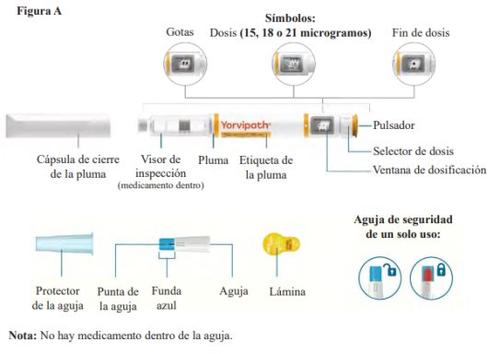
You will also need
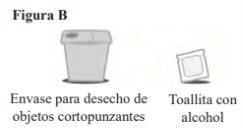
1 Preparing the pen and needle | |
Step 1 Take your Yorvipath pen. Make sure it is the correct concentration and check the expiration date. Take a needle and check the expiration dateon the needle (Figure C). Note:Remove your pen from the refrigerator 20 minutes before the first use. | Figure C
|
Step 2 Remove the cap from the pen and check the inspection window to ensure the medication inside the pen is transparent and colorless (Figure D). Important:If the medication has visible particles, do notuse the pen. Use a new pen. | Figure D
|
Step 3 Remove the needle shield (Figure E). This needle can only be used onceand is locked after use. Always use a new needle for each injection. | Figure E
|
Step 4 Fit the needle directlyonto the pen, and then screw the needle onto the pen to secure it (it will not fully tighten) (Figure F). | Figure F
|
Step 5 Remove the needle protector (Figure G) and dispose of it. Important:The blue cap should not be touched as it may block the needle. | Figure G
|
|
|
| Test the pen flow (steps A-C) only the first time you use a new pen. If your pen is already in use, go to section 3 "Prepare the injection and select the dose". |
Step A Turn the dose selector to the right 2 clicksuntil you see the drop symbol "" in the dosing window (Figure H). Note:You can always correct the selection by turning the dose selector. | Figure H
|
Step B Make the air bubbles rise to the top of the pen by pressing the inspection window (Figure I). Keep the pen with the needle tip pointing upwards. Note:Small air bubbles are acceptable. | Figure I
|
Step C Press the button and observe as the medication drops come out of the needle tip. When pressing, make sure the dose selector turns back to the "?" symbol (Figure J). Important:If you don't see medication drops, repeat this test (steps A-C) up to 5 times. If you still don't see drops, change the needle and repeat the test. | Figure J
|
3 Prepare the injection and select the dose | |
Step 6 Choose the injection area. There are twoareas of your body where you can apply the injection (Figure K). Avoid applying the injection in areas of red, swollen, or scarred skin. Choose a different injection area each time you apply the injection. |
|
Step 7 Wash your hands and clean the injection area with an alcohol swab (Figure L). | Figure L
|
Step 8 Select your dose according to your doctor's instructions (15, 18, or 21 micrograms) by turning the dose selector to the right (Figure M). Important:Make sure not to press the button when selecting the dose to avoid spilling the medication. Note:Always dispose of your pen and use a new one if you cannot set a complete dose. | Figure M
|
4 Inject the dose | |
| Use the injection administration technique recommended by your doctor or nurse. Read this entire section (steps 9-12) before starting to inject. |
Step 9 Hold the pen to place the blue cap on the injection area. Make sure you can see the dosing window (Figure N). | Figure N
|
Step 10 Push the pen straight into the skin until you hear a click and the blue cap can no longer be seen (Figure O). | Figure O
|
Step 11 Press the button all the way down and hold it firmly for 5 seconds. Make sure the dose selector turns back to the "?" symbol. This means you have administered the full dose (Figure P). | Figure P
|
Step 12 Slowly pull the pen out of the injection area. The blue cap automatically locks onto the needle and a red lock is visible (Figure Q). | Figure Q
|
5 Dispose of the used needle | |
Step 13 Unscrew the needle and dispose of it safely according to local regulations (Figure R). Do notattempt to recap the needle, as you may prick yourself on the back. | Figure R
|
Step 14 Fit the pen cap firmly onto the pen to protect it between injections and protect the medication from light (Figure S). | Figure S
|
6 Dispose of the used pen |
|
Important:Always dispose of the pen 14 days after the first use, according to local regulations. |
Locate the area. To know when 14 days have passed, it is recommended to cover the "Date of opening" field on the inner packaging.
Always discard your pen and additional needles after 14 days of use, even if there is still medication (Figure T).
This is important to ensure that you receive the full effect of the medication.
Figure T
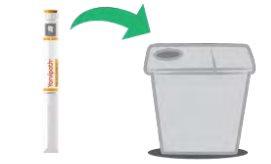
INSTRUCTIONS FOR USE
Yorvipath
420 micrograms/1.4 ml
For doses of 24, 27, or 30 microgramsonly
Injectable solution in pre-loaded pen
palopegteriparatida
Subcutaneous route
The instructions for use contain information on how to inject Yorvipath
Additional information
If you do not understand or are unable to complete any of the steps described in the instructions for use, consult your doctor or nurse.
Important information you should know before starting to use your Yorvipath pen Read and follow the package insert and these instructions for use carefully to be able to inject Yorvipath properly. Make sure you have received training from your doctor or nurse before administering the injection. This is important to ensure that you receive the correct treatment. For correct use
|
Special instructions for doses greater than 30 micrograms/day If your dose is greater than 30 micrograms/day:
|
Pen care
|
Troubleshooting
You should only test the pen flow (section 2) the first time you use a new pen (or if you think it might be damaged) to avoid wasting medication. The test checks to ensure that the medication flows through the pen, so you can receive the correct doses of the medication.
do? If you don't see drops at the tip of the needle after 5 attempts, it may be because there is no flow in the pen and needle. |
Change the needle (see section 5, step 13) and test the pen flow again (see section 2, steps A-C). You can ensure that the flow works correctly if you see the medication drop. If it still doesn't work, discard the pen and consult your healthcare professional.
The injection is only complete when you press the pusher all the way down and the dose selector has returned to the "?" and you have left the needle in the skin for 5 seconds.
Part of the medication may flow back into the pen or retreat from the injection site and remain in the skin. Pressing the pen against the skin for 5 secondshelps ensure that all the medication has been injected.
The pen does not allow setting a dose greater than the amount of medication left in the pen. If your dose is greater than the amount of medication left in the pen, you will not be able to set a full dose. You must discard your pen and take the full dose of the medication with a new one.
Unscrew and discard the needle in use (see section 5, step 13). Take a new needle from the box and start again from step 1. All boxes contain an additional needle. |
Overview of the parts
Figure A
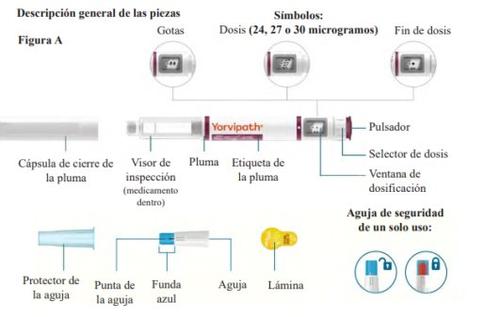
Note:There is no medication inside the needle.
You will also need
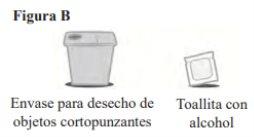
1 Preparing the pen and needle | |
Step 1 Take your Yorvipath pen. Make sure it is the correct concentration and check the expiration date. Take a needle and check the expiration dateon the needle (Figure C). Note:Remove your pen from the refrigerator 20 minutes before the first use. | Figure C
|
Step 2 Remove the closure cap from the pen and check the inspection window to ensure that the medication inside the pen is transparent and colorless (Figure D). Important:If the medication has visible particles, do notuse the pen. Use a new pen. | Figure D
|
Step 3 Remove the needle shield (Figure E). This needle can only be used onceand is locked after use. Always use a new needle for each injection. | Figure E
|
Step 4 Attach the needle directlyto your pen, and then screw the needle onto the pen until it is secured (it will not be fully tightened) (Figure F). | Figure F
|
Step 5 Remove the needle protector (Figure G) and discard it. Important:The blue cap should not be touched as it may block the needle. | Figure G
|
|
|
| Test the pen flow (steps A-C) only the first time you use a new pen. If your pen is already in use, go to section 3 "Prepare the injection and select the dose". |
Step A Turn the dose selector to the right 2 clicksuntil you see the drop symbol “” in the dosing window (Figure H). Note:You can always correct the selection by turning the dose selector. | Figure H
|
Step B Make the air bubbles reach the top of the pen by pressing the inspection window (Figure I). Keep the pen with the tip of the needle pointing upwards. Note:Small air bubbles are acceptable. | Figure I
|
Step C Press the pusher and observe as the medication drops come out of the tip of the needle. When pressing, make sure the dose selector turns back to the “?” symbol (Figure J). Important:If you don't see medication drops, repeat this test (steps A-C) up to 5 times.If drops are still not seen, change the needle and repeat the test. | Figure J
|
3 Prepare the injection and select the dose | |
Step 6 Choose the injection area. There are twoareas of your body where you can apply the injection (Figure K). Avoid applying the injection in areas of red, swollen, or scarred skin. Choose a different injection area each time you apply the injection. |
|
Step 7 Wash your hands and clean the injection area with an alcohol swab (Figure L). | Figure L
|
Step 8 Select your dose according to your doctor's indication (24, 27, or 30 micrograms)by turning the dose selector to the right (Figure M). Important:Make sure not to press the pusher when selecting the dose to avoid spilling the medication. Note:Always discard your pen and use a new one if you cannot set a full dose. | Figure M
|
4 Inject the dose | |
| Use the injection administration technique recommended by your doctor or nurse. Read this entire section (steps 9-12) before starting to inject. |
Step 9 Hold the pen to place the blue cap on the injection area. Make sure you can see the dosing window (Figure N). | Figure N
|
Step 10 Push the pen directly against the skin until you hear a click and the blue cap can no longer be seen (Figure O). | Figure O
|
Step 11 Press the pusher all the way down and hold it firmly for 5 seconds. Make sure the dose selector turns back to the "?" symbol. This means that you have already administered the full dose (Figure P). | Figure P
|
Step 12 Slowly remove the pen from the injection area. The blue cap automatically locks onto the needle and a red closure is visible (Figure Q). | Figure Q
|
5 Discard the used needle | |
Step 13 Unscrew the needle and discard it safely according to local regulations (Figure R). Do notattempt to recap the needle, as you may prick yourself on the back. | Figure R
|
Step 14 Attach the pen closure cap firmly to the pen to protect it between injections and protect the medication from light (Figure S). | Figure S
|
6 Discard the used pen |
|
Important:Always discard the pen 14 days after the first use according to local regulations. To know when 14 days have passed, it is recommended to cover the "Date of opening" field on the inner packaging. Always discard your pen and additional needles after 14 days of use, even if there is still medication (Figure T). This is important to ensure that you receive the full effect of the medication. | Figure T
|
INSTRUCTIONS FOR USE
Yorvipath
168 micrograms/0.56 ml
For doses of 6, 9, or 12 microgramsonly
Injectable solution in pre-loaded pen
palopegteriparatida
Subcutaneous route
The instructions for use contain information on how to inject Yorvipath
Additional information
If you do not understand or are unable to complete any of the steps described in the instructions for use, consult your doctor or nurse.
Important information you should know before starting to use your Yorvipath pen Read and follow the package insert and these instructions for use carefully to be able to inject Yorvipath properly. Make sure you have received training from your doctor or nurse before administering the injection. This is important to ensure that you receive the correct treatment. For correct use
|
Care of the pen
|
Troubleshooting
You should only test the pen flow (Section 2) the first time you use a new pen (or if you think it may be damaged) to avoid wasting medication. The test checks to ensure that the medication flows through the pen, so you can receive the correct doses of the medication.
If you don't see drops at the tip of the needle after 5 attempts,it may be because there is no flow in the pen and needle. Change the needle (see Section 5, Step 12) and retest the pen flow (see Section 2, Steps A-C). You can ensure that the flow is working correctly if you see the medication drop. If it still doesn't work, discard the pen and consult your healthcare professional.
The injection is only complete when you press the plunger all the way down and the dose selector has returned to the "?" and you have left the needle in the skin for 5 seconds.
Some of the medication may flow back into the pen or retreat from the injection site and remain in the skin. Pressing the pen against the skin for 5 seconds helps ensure that all of the medication has been injected.
The pen does not allow setting a dose larger than what remains. If your dose is larger than the amount of medication remaining in the pen, you will not be able to set a full dose. You must discard your pen and take the full dose of the medication with a new one. |
Overview of the parts
Figure A
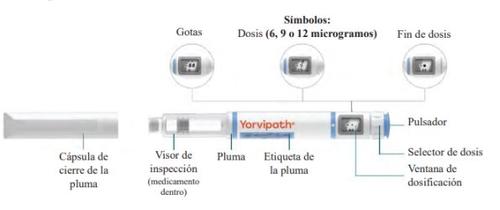
You will also need
Figure B
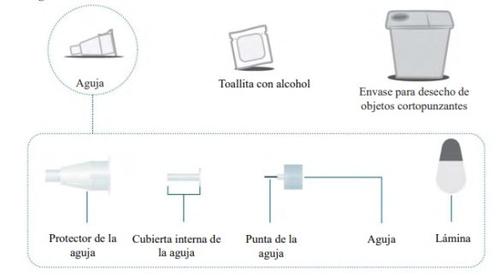
1 Preparing the pen and needle | |
Step 1 Take your Yorvipath pen. Make sure it is the correct concentration and check the expiration date.Take a needle and check the expiration dateon the needle (Figure C). Note:Remove your pen from the refrigerator 20 minutes before the first use. | Figure C
|
Step 2 Remove the closure cap from the pen and check the inspection window to ensure that the medication inside the pen is transparent and colorless (Figure D). Important:If the medication has visible do notuse the pen. Use a new pen. | Figure D
|
Step 3 Remove the needle shield (Figure E). This needle can only be used 1 time Always use a new needle for each injection. | Figure E
|
Step 4 Attach the needle directlyto your pen, and then screw the needle onto the pen until it is secure (Figure F). | Figure F
|
Step 5 Remove the needle protector and the inner needle cover (Figure G) Important:The blue cover should not be touched as it may block the needle. | Figure G
|
|
|
| Test the pen flow (Steps A-C) only the first time you use a new pen. If your pen is already in use, go to Section 3 "Prepare the injection and select the dose". |
Step A Turn the dose selector to the right 2 clicksuntil you see the drop symbol "" in the dosing window (Figure H). Note:You can always correct the selection by turning the dose selector. | Figure H
|
Step B Make the air bubbles reach the top of the pen by pressing the inspection window (Figure I). Keep the pen with the needle tip pointing upwards. Note:Small air bubbles are acceptable. | Figure I
|
Step C Press the plunger and observe as the medication drops come out of the needle tip. When pressing, make sure that the dose selector turns back to the "?" symbol (Figure J). Important:If you don't see medication drops, repeat this test (Steps A-C) up to 5 times.If you still don't see drops, change the needle and repeat the test. | Figure J
|
3 Prepare the injection and select the dose | |
Step 6 Choose the injection site. There are two areas of your body where you can apply the injection (Figure K). Avoid applying the injection in areas of red, swollen, or scarred skin. Choose a different injection site each time you apply the injection. |
|
Step 7 Wash your hands and clean the injection site with an alcohol swab (Figure L). | Figure L
|
Step 8 Select your dose according to your doctor's instructions (6, 9, or 12 micrograms)by turning the dose selector to the right (Figure M). Important:Make sure not to press the plunger when selecting the dose to avoid spilling the medication. Note:Always discard your pen and use a new one if you cannot set a full dose. | Figure M
|
4 Inject the dose | |
| Use the injection technique recommended by your doctor or nurse. Read this entire section (Steps 9-11) before starting to inject. |
Step 9 Make sure you can see the dosing window Insert the needle into the skin (Figure N). | Figure N
|
Step 10 Press the plunger all the way down and hold it firmly for 5 seconds. Make sure that the dose selector turns back to the "?" symbol. This means that you have administered the full dose (Figure O). | Figure O
|
Step 11 Slowly remove the pen from the injection site (Figure P) | Figure P
|
5 Discard the used needle | |
Step 12 Put the needle protector back on and carefully remove the needle. Insert the needle tip into the protector and secure the protector onto the needle (Figure Q). Important:Always put the needle protector back on before removing the needle to reduce the risk of needlestick injury and cross-contamination. | Figure Q
|
Step 13 Unscrew the needle and discard it safely according to local regulations (Figure R). | Figure R
|
Step 14 Put the pen closure cap back on the pen firmly to protect it between injections and protect the medication from light (Figure S). | Figure S
|
6 Discard the used pen |
|
Important:Always discard the pen 14 days after the first use according to local regulations. To know when 14 days have passed, it is recommended to cover the "Date of opening" field on the inner packaging. Always discard your pen after 14 days of use, even if there is still medication. This is important to ensure that you receive the full effect of the medication. Note: If the pen packaging includes needles, remember to throw away the additional needle when you dispose of the pen. | Figure T
|
INSTRUCTIONS FOR USE
Yorvipath
294 micrograms/0.98 ml
For doses of 15, 18, or 21 micrograms only
Injectable solution in a pre-filled pen
palopegteriparatida
Subcutaneous route
The instructions for use contain
information on how to inject
Yorvipath
Additional information
If you do not understand or are unable to complete any of the steps described in the instructions for use, consult your doctor or nurse.
Important information you should know before starting to use your Yorvipath pen Read and follow the package insert and these instructions for use carefully to be able to inject Yorvipath correctly. Make sure you have received training from your doctor or nurse before applying the injection. This is important to ensure that you receive the correct treatment. For correct use
|
Special instructions for doses greater than 30 micrograms/day If your dose is greater than 30 micrograms/day:
|
Care of the pen
|
Troubleshooting
You should only test the pen flow (Section 2) the first time you use a new pen (or if you think it may be damaged) to avoid wasting medication. The test checks to ensure that the medication flows through the pen, so you can receive the correct doses of the medication.
If you don't see drops at the tip of the needle after 5 attempts,it may be because there is no flow in the pen and needle. Change the needle (see Section 5, Step 12) and retest the pen flow (see Section 2, Steps A-C). You can ensure that the flow is working correctly if you see the medication drop. If it still doesn't work, discard the pen and consult your healthcare professional.
The injection is only complete when you press the plunger all the way down and the dose selector has returned to the "?" and you have left the needle in the skin for 5 seconds.
Some of the medication may flow back into the pen or retreat from the injection site and remain in the skin. Pressing the pen against the skin for 5 seconds helps ensure that all of the medication has been injected.
The pen does not allow setting a dose larger than what remains. If your dose is larger than the amount of medication remaining in the pen, you will not be able to set a full dose. You must discard your pen and take the full dose of the medication with a new one. If the amount of medication left in the pen is less than the dose you need, you will not be able to dial a complete dose. You must discard your pen and take the complete dose of medication with a new one. |
Overview of the parts
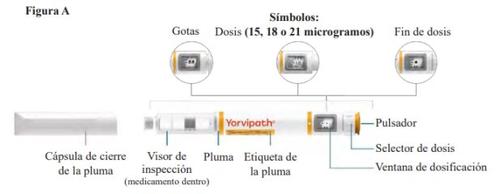
You will also need
Figure B
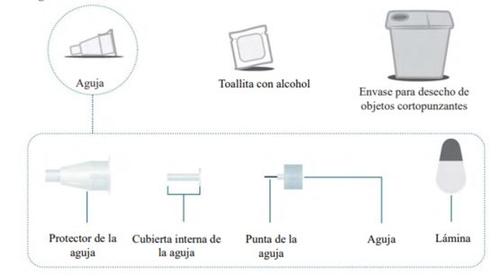
1 Preparing the pen and needle | |
Step 1 Take your Yorvipath pen. Make sure it is the correct concentration and check the expiration date.Take a needle and check the expiration dateon the needle (Figure C). Note:Remove your pen from the refrigerator 20 minutes before the first use. | Figure C
|
Step 2 Remove the closure capsule from the pen and check the inspection window to ensure that the medication inside the pen is transparent and colorless (Figure D). Important: If the medication has visible particles, do notuse the pen. Use a new pen. | Figure D
|
Step 3 Remove the needle shield (Figure E). This needle can only be used 1 time Always use a new needle for each injection. | Figure E
|
Step 4 Place the needle directlyinto your pen, and then screw the needle into the pen until it is secured (Figure F). | Figure F
|
Step 5 Remove the needle protector and the inner cap of the needle (Figure G) Immediately discard the inner cap of the needle and keep the needle protector for later. | Figure G
|
|
|
| Test the pen flow (steps A – C) only the first time you use a new pen. If your pen is already in use, go to section 3 "Prepare the injection and select the dose". |
Step A Turn the dose selector to the right 2 clicksuntil you see the drop symbol “” in the dosing window (Figure H). Note:You can always correct the selection by turning the dose selector. | Figure H
|
Step B Make the air bubbles reach the top of the pen by pressing the inspection window (Figure I). Keep the pen with the needle tip pointing upwards. Note:Small air bubbles are acceptable. | Figure I
|
Step C Press the button and observe as the medication drops come out of the needle tip. When pressing, make sure that the dose selector turns back to the “?” symbol (Figure J). Important:If you do not see medication drops, repeat this test (steps A – C) up to 5 times.If you still do not see drops, change the needle and repeat the test. | Figure J
|
3 Prepare the injection and select the dose | |
Step 6 Choose the injection site. There are two areas of your body where you can apply the injection (Figure K). Avoid applying the injection in areas of red, swollen, or scarred skin. Choose a different injection site each time you apply the injection. |
|
Step 7 Wash your hands and clean the injection site with an alcohol swab ( Figure L). | Figure L
|
Step 8 Select your dose according to your doctor's instructions (15, 18, or 21 micrograms) by turning the dose selector to the right (Figure M). Important:Make sure not to press the button when selecting the dose to avoid spilling the medication. Note:Always discard your pen and use a new one if you cannot dial a complete dose. | Figure M
|
4 Inject the dose | |
| Use the injection administration technique recommended by your doctor or nurse. Read this entire section (steps 9 - 11) before starting to inject. |
Step 9 Make sure you can see the dosing window. Insert the needle into the skin (Figure N). | Figure N
|
Step 10 Press the button all the way down and hold it firmly for 5 seconds. Make sure that the dose selector turns back to the “?” symbol. This means that you have administered the complete dose (Figure O). | Figure O
|
Step 11 Slowly remove the pen from the injection site.(Figure P) | Figure P
|
5 Discard the used needle | |
Step 12 Put the needle protector back on to carefully remove the needle. Insert the needle tip into the protector and secure the protector on the needle (Figure Q). Important: Always put the needle protector back on before removing the needle to reduce the risk of needlestick injury and cross-contamination. | Figure Q
|
Step 13 Unscrew the needle and dispose of it safely according to local regulations (Figure R). | Figure R
|
Step 14 Fit the closure capsule of the pen firmly onto the pen to protect it between injections and protect the medication from light (Figure S). | Figure S
|
6 Discard the used pen |
|
Important:Always discard your pen 14 days after the first use according to local regulations. To know when 14 days have passed, it is recommended to cover the ?Opening Date? field on the packaging. Always discard your pen after 14 daysof use, even if there is still medication. This is important to ensure that you receive the full effect of the medication. | Figure T
|
INSTRUCTIONS FOR USE
Yorvipath
420 micrograms/1.4 ml
For doses of 24, 27, or 30 microgramsonly
Injectable solution in pre-filled pen
palopegteriparatida
Subcutaneous route
The instructions for use contain
information on how to inject
Yorvipath
Additional information
If you do not understand or are unable to complete any of the steps described in the instructions for use, consult your doctor or nurse.
Important information you should know before starting to use your Yorvipath pen Read and follow the package insert and these instructions for use carefully to be able to inject Yorvipath properly. Make sure you have received training from your doctor or nurse before applying the injection. This is important to ensure that you receive the correct treatment. For correct use
|
Special instructions for doses greater than 30 micrograms/day If your dose is greater than 30 micrograms/day:
|
Care of the pen
|
Troubleshooting
You should only test the pen flow (section 2) the first time you use a new pen (or if you think it might be damaged) to avoid wasting medication. The test performs checks to ensure that the medication flows through the pen, so you can receive the correct doses of the medication.
do? If you do not see drops on the needle tip after 5 attempts,it may be because there is no flow in the pen and needle. Change the needle (see section 5, step 12) and test the pen flow again (see section 2, steps A-C). You can ensure that the flow works correctly if you see the medication drop. If it still does not work, discard the pen and consult your healthcare professional.
The injection is only complete when you press the button all the way down and the dose selector has turned back to the “?” and you have left the needle in the skin for 5 seconds.
Part of the medication may flow back into the pen or retreat from the injection site and remain in the skin. Pressing the pen against the skin for 5 secondshelps ensure that all the medication has been injected.
The pen does not allow setting a dose greater than the amount of medication left in the pen. If your dose is greater than the amount of medication left in the pen, you will not be able to dial a complete dose. You must discard your pen and take the complete dose of medication with a new one. |
Overview of the parts
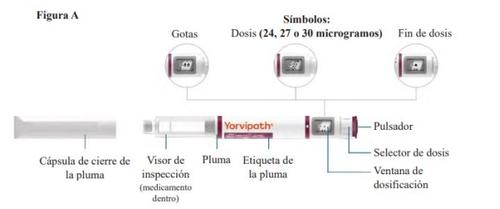
You will also need
Figure B
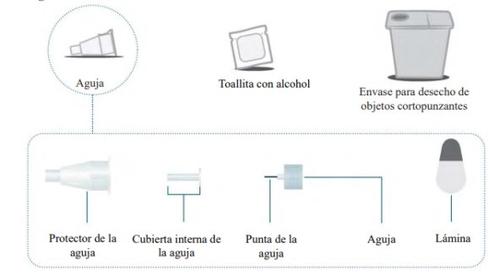
1 Preparing the pen and needle | |
Step 1 Take your Yorvipath pen. Make sure it is the correct concentration and check the expiration date.Take a needle and check the expiration dateon the needle (Figure C). Note:Remove your pen from the refrigerator 20 minutes before the first use. | Figure C
|
Step 2 Remove the closure capsule from the pen and check the inspection window to ensure that the medication inside the pen is transparent and colorless (Figure D). Important: If the medication has visible particles, do notuse the pen. Use a new pen. | Figure D
|
Step 3 Remove the needle shield (Figure E). This needle can only be used 1 time Always use a new needle for each injection. | Figure E
|
Step 4 Place the needle directlyinto your pen, and then screw the needle into the pen until it is secured (Figure F). | Figure F
|
Step 5 Remove the needle protector and the inner cap of the needle (Figure G) Immediately discard the inner cap of the needle and keep the needle protector for later. | Figure G
|
|
|
| Test the pen flow (steps A - C) only the first time you use a new pen. If your pen is already in use, go to section 3 "Prepare the injection and select the dose". |
Step A Turn the dose selector to the right 2 clicksuntil you see the drop symbol "" in the dosing window (figure H). Note:You can always correct the selection by turning the dose selector. | Figure H
|
Step B Make the air bubbles reach the top of the pen by pressing the inspection window (figure I). Keep the pen with the needle tip pointing upwards. Note:Small air bubbles are acceptable. | Figure I
|
Step C Press the plunger and observe as the medication drops come out of the needle tip. When pressing, make sure the dose selector turns back to the symbol "?" (figure J). Important:If you do not see medication drops, repeat this test (steps A - C) up to 5 times.If you still do not see drops, change the needle and repeat the test. | Figure J
|
3 Prepare the injection and select the dose | |
Step 6 Choose the injection site. There are two areas of your body where you can apply the injection (figure K). Avoid applying the injection in areas of red, swollen, or scarred skin. Choose a different injection site each time you apply the injection. |
|
Step 7 Wash your hands and clean the injection site with an alcohol wipe (figure L). | Figure L
|
Step 8 Select your dose according to the doctor's indication (24, 27, or 30 micrograms) by turning the dose selector to the right (figure M). Important:Make sure not to press the plunger when selecting the dose to avoid spilling the medication. Note:Always discard your pen and use a new one if you cannot mark a complete dose. | Figure M
|
4 Inject the dose | |
| Use the injection administration technique recommended by your doctor or nurse. Read this entire section (steps 9 - 11) before starting to inject. |
Step 9 Make sure you can see the dosing window. Insert the needle into the skin (figure N). | Figure N
|
Step 10 Press the plunger all the way down and hold it firmly for 5 seconds. Make sure the dose selector turns back to the symbol "?". This means you have administered the complete dose (figure O). | Figure O
|
Step 11 Slowly withdraw the pen from the injection site (figure P) | Figure P
|
5 Dispose of the used needle | |
Step 12 Put the needle protector back on to carefully remove the needle. Insert the needle tip into the protector and secure the protector on the needle (figure Q). Important:Always put the needle protector back on before removing the needle to reduce the risk of pricking and cross-contamination. | Figure Q
|
Step 13 Unscrew the needle and dispose of it safely according to local regulations (figure R). | Figure R
|
Step 14 Fit the pen cap firmly onto the pen to protect it between injections and protect the medication from light (figure S). | Figure S
|
6 Dispose of the used pen |
|
Important:Always discard the pen 14 days after the first use according to local regulations. To know when 14 days have passed, it is recommended to cover the "Date of opening" field on the inner packaging. Always discard your pen after 14 days of use, even if there is still medication (figure T). This is important to ensure you receive the full effect of the medication. Note: If the pen packaging includes needles, remember to throw away the additional needle when disposing of the pen. | Figure T
|
- Country of registration
- Active substance
- Prescription requiredYes
- Manufacturer
- This information is for reference only and does not constitute medical advice. Always consult a licensed doctor before taking any medication. Oladoctor is not responsible for medical decisions based on this content.
- Alternatives to YORVIPATH 168 micrograms/0.56 ml injectable solution in pre-filled penDosage form: INJECTABLE, 294 micrograms/0.98 mlActive substance: palopegteriparatideManufacturer: Ascendis Pharma Bone Diseases A/SPrescription requiredDosage form: INJECTABLE, 420 micrograms/1.4 mlActive substance: palopegteriparatideManufacturer: Ascendis Pharma Bone Diseases A/SPrescription requiredDosage form: INJECTABLE, 250 micrograms/mlActive substance: teriparatideManufacturer: Gp Pharm S.A.Prescription required
Online doctors for YORVIPATH 168 micrograms/0.56 ml injectable solution in pre-filled pen
Discuss dosage, side effects, interactions, contraindications, and prescription renewal for YORVIPATH 168 micrograms/0.56 ml injectable solution in pre-filled pen – subject to medical assessment and local rules.





